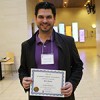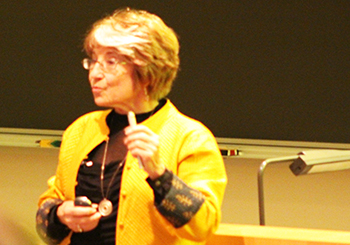The highlight of this very successful event, held on March 11, 2016, was the keynote speech by Dr. Mina Bissell, Distinguished Scientist, Life Sciences Division, Lawrence Berkeley National Laboratory. Dr. Bissell spoke on “Why Don’t We Get More Cancer: The Critical Role of Extracellular Matrix and Microenvironment in Metastasis and Dormancy.” Dr. Bissell’s abstract is at the bottom of this webpage.
Research Day 2016 featured two competitions – talks and posters. The best ones (see below) received cash prizes and certificates:




Above photos, left to right: Post-Doctoral Fellow Talk Winner Antoine Dufour,
Senior Graduate Talk Winner Jia Wang, Senior Graduate Talk Second Place Madison Bolger-Munro,
Junior Graduate Talk Winner Sarah Gignac



Above photos, left to right: Junior Graduate Talk Second Place Tamiza Nanji, Junior Graduate Poster Winner Jordan Shimell, Undergraduate Poster Winner Clarence Yeung
Click here to view more photos from the event
The keynote was sponsored by CELL Research Group. Other sponsors of LSI Graduate Students Association (GSA) Research Day 2016 were: Froggabio, NEB, VWR, D-Mark Biosciences, GSS, IDT, PDA and the Vancouver Whitecaps.
Dr. Bissell’s Abstract:
Cancer is a tissue-specific disease. Thus to understand malignancy, one must understand the normal tissue and the organ from which the malignant tumors develop.
To understand initiation of breast tumors one must consider the health of the entire organ within the context of the individual: the age of the individual and the medical condition, not only the cells that become or have become malignant but the entire tissue and the microenvironment of the cells that have been targeted to become tumors, and eventually the malignant tumors. This means one has to understand the organ architecture, the tissue context, the shape of the cells, the health of the surrounding cells, the immune status of the host. To understand metastasis of the breast, one needs to know how the tissue and organ developed and how the embryonic cells moved to make the tissue. To understand dormancy, one needs to learn how the cells in the normal tissue become quiescent and to understand drug resistance, one has to ask why and how the normal cells are much more resistant to resist therapy than the tumor cells?
